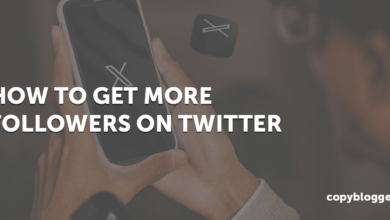How To Make (Substantial) Money On Social Media

There are plenty of multi-millionaires that have built their wealth from their social media following, and most of them are not Instagram influencers or YouTube stars.
For example, Nick Huber has built several businesses that now generate $400,000 per month thanks to his social media audience.

And George Blackman made nearly $75,000 on his first launch with less than 8,000 followers on Twitter.

In this post, I’ll break down the best ways to make money on social media, along with the pros and cons and specific examples of each method.
Before we jump into these methods, here are a few of the most commonly asked questions about making money on social media.
How big of a following do I need to make money on social media?
The size of your audience does not always correlate with the profitability of your audience.
So instead of focusing on follower count, think about the value of your audience.
Value mainly comes down to the niche you select.
For example, an audience of 100 lawyers will be much more profitable than an audience of 100, or even 1,000 college students, for two reasons:
- A lawyer likely has more money to spend.
- A lawyer will justify spending more money on a product or service that will in turn generate an ROI and make their business more efficient or profitable.
So there isn’t a specific number you need to hit to make money on social media, but you do need to establish trust and credibility with your audience.
How much money can I make on social media?
You can make six, seven, or even eight figures on social media. The main factors that impact how much money you can make on social media include:
- The niche you select: You’ll make more money with an audience of lawyers than an audience of college students).
- How you choose to monetize: We’ll discuss the profitability of each of the monetization methods below.
- The trust and size of your audience: If you have 1,000 lawyers who trust you deeply, you’ll be more profitable than an audience of 100 lawyers who only somewhat trust you.
How hard is it to make money on social media?
It’s not hard to make money on social media if you pick the right niche and use the right systems to build a strong relationship with a high-value audience.
Therefore, if you want to make money on social media, it comes down to these factors:
- Select a niche in which you’re an expert: It’s much easier to post helpful content consistently if you’re already an expert on a specific topic, as you won’t have to do much research to create the content. For example, if you already have 10 years of experience as a personal trainer, you can probably create a lot of content around the topic of personal training.
- Select a niche that has a high-value audience: If your audience is a group of successful entrepreneurs or executives, you’ll have a lot more monetization opportunities than if your audience is a group of knitting enthusiasts.
- Your social media strategy: If you have the right systems and processes to consistently create content that’s helpful to your audience, you’ll build a following faster and be able to monetize sooner.
Now that you know the monetization opportunities around social media, here are the six best ways to make money on social media, along with the pros and cons of each and specific examples of each method.
1. Build Your Own Business
One of the biggest challenges with starting a business is acquiring customers and finding product market fit.
Yet if you’ve built a loyal following on social media before starting your business, you already have a loyal audience to sell to. You can also bypass the process of finding product market fit, as you can simply ask your audience about their pain points and then build a business that solves those problems.
Building your own business is also the most profitable long-term strategy as you have virtually limitless scale potential (depending on the business you choose to start).
If you don’t want to operate the business yourself, you can partner with an operator to run the business for you.
Examples
Here are a few examples of content creators who monetized their social media following by building a business.
Alex Lieberman
Alex Lieberman was the co-founder of Morning Brew and today, he focuses primarily on creating social media content and building businesses by leveraging his social media following.
He recently started the company Story Arb, a ghostwriting agency, and in the first year of operation, it crossed $70,000 in revenue per month.

The entire company began as a simple Tweet and he has sourced nearly all of his clients through his social media following.
However, keep in mind that he has been building a social media presence for the past several years before building this business.
Alexandra Lourdes
Alexandra Lourdes is an excellent example of how even a cafe can use social media to make money. She has millions of followers on Instagram and TikTok where vlogs about her life as a cafe owner in Las Vegas.

Over the past several years, she has leveraged her social media following to open several cafes/restaurants throughout Las Vegas and has also been invited to cater for celebrity events, including the Super Bowl.
Many of her customers travel across the United States specifically to stop by her famous cafes. So Alex is excellent proof that you can even build a chain of restaurants from a social media following.
Profit Potential

Pros
- Building a business is the most profitable option as businesses have virtually limitless scalability (depending on the business model you choose).
- You have full control over the quality of the product/service.
Cons
- Starting any business requires a lot of work including hiring people, managing cash flow, investing in the business in the early days, and more.
- Growing a business takes time and it might not be profitable immediately.
- Highest risk as you’re putting in your own investment.
2. Invest In Existing Businesses
If you don’t want to build a business from scratch, but you still want the upside opportunity of owning a business, another option is to acquire a stake in an existing business.
While you can buy a business outright, you might not want the headache of managing daily operations or hiring an operator. Additionally, if you learn you aren’t a great manager, there’s a lot of risk of the entire business failing.
Therefore, making a minority investment in an existing business that aligns with your audience is a great strategy to monetize your social media following.
If you’re not sure what businesses to invest in, look at the products you and your audience already use and reach out to the founders of those companies to see if you can invest.
Examples
Here are a few examples of people who have invested in existing businesses with great success.
Nick Huber
Nick Huber built a storage startup business and today he has over 350,000 followers on Twitter (X). After selling his storage business for seven figures, he has built several businesses in the space and most of his customers come from his Twitter following.
Here’s a full breakdown of how he has managed to clear $400,000 in personal profit through various businesses he has built off of his social media following.
As you can see, he only owns a percentage of most of these businesses and many of them are either expenses he would traditionally have to cover on his balance sheet or expenses his audience is already paying to other companies.


Alex Hormozi
Alex Hormozi is the poster child of social media monetization. He talks about his experience scaling businesses, so he then monetizes his following by acquiring majority stakes in qualified businesses and using the frameworks he discusses in his content to scale them.
Our content repurposing blog post describes the strategy he used to earn over a million followers in just six months, but the key number he revealed is that his business also grew from $7 million to $13 million per month in revenue.

Profit Potential

Pros
- You’re not responsible for running daily operations or managing a team and instead simply receive a check when the business makes money or sells.
- You can immediately earn the rewards of a business that is already making money.
- Similar to building your own business, it has excellent scalability potential (assuming you did your research on the business).
Cons
- Investing in a business often requires capital (though this isn’t always the case depending on the quality/size of your audience).
- You have limited control over the team (depending on your investment amount and the contract details) and you can’t always guarantee that the founder will make the decisions you would make.
- If you decide you don’t want to be part of the business anymore, it can be difficult to get out of your investment.
3. Sell Coaching/Courses
If your audience already trusts you and finds value in your social media content, many of them will be happy to pay for premium step-by-step content (courses) or personalized advice (coaching).
Selling courses requires some upfront effort, but neither coaching nor courses require any capital investment, making both low-risk options.
The only downside of selling courses is that most people with social media followings use this monetization strategy, so the quality of your course needs to be high to stand out.
For example, many customers now expect courses to include templates, personalized feedback, or coaching in the course package rather than just content.
Examples
Here are a few examples of people who successfully monetized their social media audience through courses and coaching.
Ali Abdaal
Ali Abdaal has over 5 million YouTube subscribers, and his primary monetization strategy is selling courses. In 2023, he generated over $5 million in revenue from selling his Part-Time YouTuber course.
He offers several different pricing tiers for the course. The main Academy is $995, and the Accelerator, which also gives users access to a personal Slack group with Ali’s team, is priced at $4,995.
However, Ali’s courses are much more than simple content-based courses. If you want ideas to make your course a truly premium product, look at the bonuses he includes in both the Academy and Accelerator versions.
George Blackman
George Blackman is a great example of someone with a modest follower count (less than 8,000 followers on Twitter/X) who succeeded in making nearly $75,000 from his very first course launch.

His course launch was likely successful because he picked a very small niche (YouTube script writing), and he’s truly an expert in the field as he was personally a YouTube script writer for Ali Abdaal, Ed Lawrence (Film Booth), and even Thomas Frank.
Therefore, pick a specific niche where you’re truly the ultimate expert, as this will help you stand out and allow you to place a high price tag on your course.
Profitability

Pros
- Once you’ve built the course, you can automate most of it, making it one of the most truly passive income options.
- It requires virtually no capital to create a course or sell coaching.
- It’s very low risk as you’ve only lost your time if a course fails, and you don’t lose anything if nobody buys your coaching.
- Coaching and courses help you learn more about your audience’s pain points, which can help you build businesses down the road.
Cons
- Coaching specifically isn’t always scalable, as you’re still trading your time for money.
- While courses are more scalable, there are very few creators who make more than $5 million per year selling them, so they rarely have the same scale potential as a business.
- There are a lot of courses out there, so you really have to establish yourself as the premier expert in your niche and deliver a product that is a step above the rest to make it successful.
4. Sell Memberships
The main value of memberships and communities is the other members. If you build a strong community of high quality members, communities and memberships are excellent businesses as you earn recurring revenue, and members won’t want to leave if they form connections with peers.
Many people even prefer communities and memberships to courses because they can ask specific questions and receive multiple perspectives from peers and experts.
The downside with memberships and communities is that they usually require you to actively moderate the quality of the community. In addition, members may expect you to either actively engage in the community or consistently create premium content.
In addition, most people aren’t accustomed to paying more than $50 to $100 per month for access to a community, so these businesses tend to be less scalable.
Examples
Here are a few examples of social media creators who successfully monetize their audience through memberships.
Jay Clouse
Jay Clouse recently revealed how he monetizes his audience, and most of his revenue (about $161,327.40) comes from his membership offering, The Lab.

In the Lab, Jay offers premium content, community, “hot seats,” networking opportunities, and more.

While his membership is very successful, he also does a great job moderating the group and ensuring the members are high quality.
Profitability

Pros
- It’s a recurring revenue model, so you receive a steady annual income stream.
- You can talk with paying customers one-on-one to learn more about their pain points and build a deeper relationship with them, which can help you build other businesses and income streams.
- It has a low barrier to entry as you don’t need any capital to start a membership community.
- It has little to no risk, as you won’t lose any capital if it fails. Additionally, it doesn’t require much effort upfront (like a course) to begin your membership, as the community is the main value people are paying for.
Cons
- Managing a community requires more active effort from you to moderate members. While you can outsource basic management tasks, members want feedback from you directly, and you must cultivate a culture that includes some high-level members. You may also offer live streams, monthly calls, or other premium forms of content that require time commitment from you.
- Creating a quality community is difficult as the members are the real value, and that can be difficult to control.
- It’s difficult to shut down a membership community if you don’t enjoy it anymore.
- Keeping participants active and engaged can be tricky as you must continue providing new value each month. If they churn, you lose the recurring revenue.
- Very few membership programs generate more than $5 million in revenue.
5. Sell Affiliate Products
Selling affiliate products is arguably one of the easiest monetization strategies, as you simply give your audience a link to a product, and you earn a commission whenever your audience uses that link to make a purchase.
You can also continue earning revenue from these links long after posting them. For example, if you put an affiliate link in a blog post two years ago, you can still earn money from it today.
The key to monetizing through affiliate marketing is to ensure you only promote high-quality products you truly believe in. Otherwise, you’ll sacrifice trust with your audience, making it difficult to sell products in the future, and you may lose your followers altogether.
Affiliate marketing is a great option if you’re just starting to monetize your audience because it’s very easy and has minimal risk. The main downside of affiliate marketing is that it’s a fairly unpredictable income stream, and you only earn a small percentage of the revenue that you actually drive for the business, making it one of the least profitable social media monetization strategies.
Examples
Here are a few examples of creators who have successfully monetized their following through affiliate marketing.
Vanessa Lau
Vanessa Lau has a strong following on YouTube and Instagram, and she recently shared how much she makes from affiliate marketing each month:

She made over $7,000 in February, whereas she only made about $3,700 in March. Therefore, affiliate marketing revenue is rather inconsistent, and contributes a fairly small percentage to the $80,000 she makes each month from social media marketing.
Profitability

Pros
- It’s a truly passive business model. You earn money whenever someone buys through your link, so you don’t have to deal with any customer support.
- It requires very little effort to start. Most brands allow you to become an affiliate through a simple online application.
- It requires zero capital to become an affiliate.
Cons
- You can’t control the product quality, so if customers aren’t happy with the products, you might lose trust and credibility with your audience.
- It isn’t very scalable as taking on too many affiliates can damage trust with your audience and you also only receive a very small percentage of the sale of each product or service.
- You only make money if your audience buys, so income can vary dramatically from month to month.
6. Sponsored Content And Brand Deals
Sponsored content and brand deals are a great way to make consistent revenue by promoting other products and services. Unlike affiliate marketing, where you only earn commissions if your audience purchases products or services, brand deals and sponsored content allow you to earn a lump sum of money upfront.
Therefore, you earn money regardless of whether your audience purchases the products or services offered through the brand. This reduces your risk and allows you to earn a more consistent income.
The drawback with sponsored content and brand deals is that it requires more work from you upfront as you’ll have to find and close the brand deals, and you may also have to create content specifically for that brand.
Examples
Sahil Bloom
Sahil Bloom is a great example of a creator who earns significant revenue through sponsorships and brand deals.
On a podcast episode, he revealed that he makes between $3,500 and $6,000 per email through sponsorships, which would come out to between $28,000 to $45,000 per month as he sends two weekly emails.
He primarily works with ConvertKit’s sponsorship network to land sponsors, though you can also find sponsors yourself.
Profitability

Pros
- You receive a lump sum of money up front, making it a very predictable income source.
- It’s a relatively passive income source as most creators only have to make a single piece of content for each brand deal.
- Some creators don’t enjoy creating content specifically for their sponsors and don’t like that they have deadlines.
Cons
- Finding and closing brand deals can be difficult. Like any service business, you may have to source, nurture, and convert brands to win sponsorships.
- Sponsorships have a limited upside as you can only sell a limited number of sponsorship spots to maintain trust with your audience. Additionally, brands will only agree to a sponsorship deal if they estimate they will still make a profit after the sponsorship fees, so it’s still not as profitable as if you owned the business yourself.
- Some creators don’t enjoy creating content specifically for their sponsors and don’t like that they have deadlines.
7. Platform Payouts
Many platforms now pay creators for their efforts, and some creators are making six or even seven figures through platform monetization.
However, these creators typically target mass audiences and generate millions of monthly views. Therefore, this monetization strategy isn’t as effective for micro-influencers.
Here are guides for monetization and requirements on various platforms:
Even if you have a small audience, setting up monetization on each platform is still worthwhile, as earning money requires virtually no additional effort on your part.
Examples
Preston Arsement
YouTuber Preston Arsement makes about $16 million annually and about 50% of his total revenue comes from YouTube ads.
However, keep in mind that he has about 15 million subscribers.
Tiffany Fong
Tiffany Fong has just over 100,000 Twitter followers and recently revealed that she made just over $667 in her first month as a monetized creator on Twitter.
While the platform payouts are still relatively modest, it’s worthwhile as it requires virtually no ongoing effort from the creator.
Profitability

Pros
- It’s a truly passive income source, as you don’t have to do anything other than continue posting content on the platform to make money.
- Unlike affiliate marketing and brand deals, platform payouts don’t interrupt the audience’s experience with your content.
Cons
- While it scales with your audience, most platforms pay a tiny percentage to their creators, making it significantly less scalable than building a business or other monetization options.
- You have to have a very large audience to make money with platform payouts, meaning it’s usually best for creators targeting the masses.
You don’t need millions of followers to make money on social media, but you do need an effective content marketing strategy to build a strong relationship with the right audience.
While we offer plenty of free resources about personal branding, content marketing, and social media here on the Copyblogger blog, the Copyblogger Academy is a course and community that can help you build your social media presence in less time.
Inside, you’ll have access to several different courses on content marketing, copywriting, email marketing, and personal branding, all of which are taught by either Tim Stoddart (who has built and currently operates multiple seven-figure businesses) and Charles Miller (who has millions of social media followers and has built six and seven figure businesses through social media).
You’ll also have access to a community of peers and can ask them for feedback as well.
To see if the Copyblogger Academy is the right fit for you, try it out today. If you aren’t completely satisfied, we’ll give you a full refund so it’s 100% risk-free.





